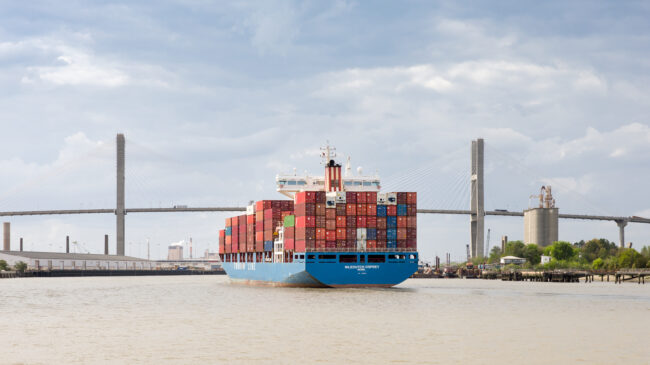America’s ports and harbors are critical links in the global supply chain. Ensuring that U.S. harbors have sustainable funding sources is crucial to a stable supply chain. However, the current Harbor Maintenance Trust Fund is not a suitable long-term funding mechanism.
The Harbor Maintenance Trust Fund (HMTF) is funded by the Harbor Maintenance Fee (HMF) imposed on imported cargo, domestic cargo, passengers on cruise ships, and ships entering a foreign trade zone. Created in 1986, the Harbor Maintenance Fee was originally a 0.04% tax on the goods being loaded and offloaded at ports. The fund quickly grew to cover 100% of the U.S. Army Corp of Engineers (USACE) port operations and maintenance expenditures across the country and to split the costs with ports and other local users of new project construction.
But the fund has significant faults. From excluding some beneficiaries of ports and harbors from paying into the HMTF to forcing larger, more cargo-intensive ports to subsidize smaller ports, the Harbor Maintenance Fee and Harbor Maintenance Trust Fund are plagued by inefficiencies. Reforming the Harbor Maintenance Fee to be a user fee based on the maintenance costs imposed by a vessel would provide the Harbor Maintenance Trust Fund with a more robust funding mechanism, allowing greater spending flexibility and providing more value.
The problem of cross-subsidization is an element of the HMTF that is ripe for reform. Ports with low cargo traffic are major HMTF recipients, despite cargo vessels generating the lion’s share of HMTF revenues. These other ports are used by commercial fishers and recreational boaters who use the smaller, shallower waterways and contribute almost nothing to the HMTF. A 2011 Congressional Research Service report found many examples of ports receiving little cargo shipping, such as Yaquina Bay and Harbor in Oregon. However, Yaquina Bay is essential for commercial fishing and is considered a major recreational port. It received over $25 million in HMTF funds from 2001 to 2011 but has not had a cargo ship pass through in years.
Instead of using the Harbor Maintenance Trust Fund to sustain these shallow-draft ports, policymakers should use the Sports Fish Restoration and Boating Safety Trust Fund to keep these smaller commercial fishing and recreational waters safe and navigable. It is a fund to which these groups of beneficiaries already contribute through taxes on fuel and fishing equipment, making it a logical source of replacement funding.
But ports with limited cargo traffic are not the only ports benefiting from the HMTF without equal contribution. The Eastern Seaboard and Gulf Coasts have naturally shallower coastlines than much of the West Coast, making harbor development and depth maintenance more expensive than their West Coast counterparts. While these East and Gulf Coast ports—if they receive cargo— do contribute to the HMTF, their maintenance costs are much higher than those on the West Coast due to the costs incurred from dredging them to often unnecessary depths to accommodate deep-draft cargo vessels that rarely, if ever, use them.
In contrast, naturally, deep ports tend to receive high cargo traffic and generate massive amounts of revenue for the HMTF. They have had a specific designation since the Water Resources Reform and Development Act (WRRDA) of 2014: donor ports. These ports, which generate at least $15 million in Harbor Maintenance Fee revenue in a year, tend to receive very little HMTF money in return. The ports of Los Angeles and Long Beach are good examples. In 2012, for every dollar traffic at these ports generated for the HMTF, the ports received less than one cent back.
The best solution to this cross-subsidization would be to guarantee a share of the HMTF revenue generated by ports for their own improvements. This would ensure that the ports with higher cargo traffic receive more equitable funding from the HMTF. As it stands, however, that money cannot be used for any purpose aside from dredging.
By expanding the uses of HMTF money for these ports for projects like pier and wharf repairs, we can incentivize their continued success and end much of the cross-subsidization problem in port development. It would also send a key market signal to developers. Not every port needs to be able to receive deep-draft cargo vessels, and reserving a share of HMF revenue for the ports that generate it would ensure port development takes place only where it makes economic sense.
Another problem facing the HMTF is the high costs of maintenance dredging. The U.S. faces substantially higher dredging costs than ports around the world. A study for the state of Louisiana from 2011 found that the volume of material dredged around the globe had increased dramatically—by 1,400% in the Middle East, 260% in Australia, 170% in China, and 150% in Europe—and costs per unit of material dredged had declined.
In contrast, the U.S. has observed increasing prices and decreasing dredge volumes. The overall price of dredging in the U.S. has increased from $2.43 in 1970 to $10.33 per cubic yard in 2020 (adjusted for inflation), or by 325%. These higher prices have not led to a larger volume of material being dredged. This difference is due to many factors, chief among them the Foreign Dredge Act of 1906, which, functioning similarly to the Jones Act’s impact on shipping, bans cheaper foreign dredges from U.S. waters.
Due to reduced competition, dredging work in the U.S. costs a lot more. USACE data shows that one of four U.S. firms is the sole bidder on more than 33% of dredge contracts. This is not solely due to a lack of domestic competition. Foreign dredging firms use semi-submersible heavy-lift vessels to move dredge fleets efficiently between projects, but none are available in the U.S. Jones Act-compliant fleet.
Prices for dredging will likely continue to rise as long as international competition is barred from U.S. waters. The HMTF is overfunded, and funds are poorly allocated. Adjusting the current HMF to a user fee, directly tied to the costs incurred by each vessel type, would ensure that all beneficiaries are paying for the services that benefit them and would keep the Harbor Maintenance Fee within its constitutional obligations as a user fee and not a tax.
By ending cross-subsidization between ports, the U.S. can once again begin to encourage port development where it makes the most sense and operates most cost-effectively, as well as giving Harbor Maintenance Trust Fund donor ports greater access to the funds they generate.

